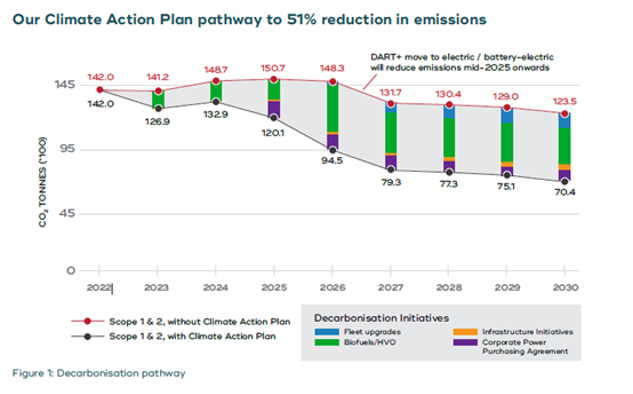The ambitious plan will be delivered while rail services are expanded, with passenger journeys of 80 million per annum targeted by 2030, up from a pre-Covid high of 50.1 million journeys, and a doubling of rail freight volumes anticipated, the firm noted.
The 51% emissions reduction will be achieved through a reduced reliance on diesel through alternative fuels on existing fleets; transitioning to electric-powered fleet; green energy generation and corporate purchasing power agreements; and fleet and building works to reduce energy consumption.
Irish Rail chief executive Jim Meade said, “Rail has always been the most sustainable mode of land transport, and now we have the opportunity and the commitment to enhance this further. Our investment program, funded by the National Transport Authority under the National Development Plan is critical, with European funding also supporting our Cork Area Commuter Rail plan.
“We also commit in this Climate Action Plan to pursue innovative solutions to green energy generation, the use of alternative fuels and improvements to our buildings and existing fleets to reduce energy consumption,” Meade added.
Irish Rail’s 2018 baseline combined Scope 1 and 2 greenhouse gas emissions amounted to 144,400 tons of CO2. These emissions account for approximately 1% of the total national transport emissions, according to the Sustainable Energy Authority of Ireland (SEAI).
In 2022, diesel fuel consumed through rail and road operations accounted for 85% of the company’s overall emissions. Reducing its reliance on diesel fuel is critical to the business’s decarbonization pathway.
To meet its public sector target of 51% reduction in emissions by 2030, Irish Rail must reduce its combined annual Scope 1 and 2 emissions to circa 70,800 tons, while growing the passenger and rail freight businesses at the same time. This in turn supports the overall national reduction in transport emissions.

Above: Irish Rail's decarbonization pathway.
According to Irish Rail, four elements will combine to achieve the firm's Climate Action Plan targets:
Reducing the fleet reliance on diesel:
- All diesel fleets will operate with at least a 35% biofuel/hydrotreated vegetable oil (HVO) blend.
- Increase in rail freight operations – fueled by HVO and/or green hydrogen.
- Fuel all track maintenance vehicles with HVO.
- Moving all road fleet to electric or HVO fuel by 2030.
Transitioning to electric-powered fleet:
- Electric and battery-electric trains, and associated infrastructure will operate for the DART+ network in Dublin, and to be developed for the Cork commuter rail network, allowing the retirement of older diesel fleets.
- A new Enterprise fleet will allow for future electric power on the Dublin Belfast route.
- Planning to be advanced for the electrification of key sections of the InterCity network to meet net zero goals for 2050.
Green energy generation
- Existing and new DART fleet will benefit from increasing renewable energy content of the national grid, doubling to 80% by 2030 compared to circa 40% currently, as well as the proposed Iarnród Éireann Corporate Power Purchasing Agreements (CPPAs).
- PV solar panels will be installed across Irish Rail buildings where feasible, with almost 200 panels already installed at the new National Train Control Centre, and opportunities identified at Inchicore, Portlaoise and Drogheda.
Reducing energy consumption (phased approach up to 2030):
- Intercity railcar fleet targeted to be converted to hybrid power with on-board battery, delivering a carbon emission reduction of up to 30%.
- Upgrades to the remaining Dublin commuter rail fleet to deliver a 20% reduction in fuel consumption and emissions.
- Building upgrades will deliver improved energy efficiencies with BERs going from G to B/C whilst protecting the heritage of the buildings.
- All new buildings and major upgrades are to be built to Nearly Zero Energy Building Standard.
- Reducing electric and gas consumption by 1.5% to 2% per annum through supply side initiatives
Read Iarnród Éireann’s full Climate Action Plan here.

